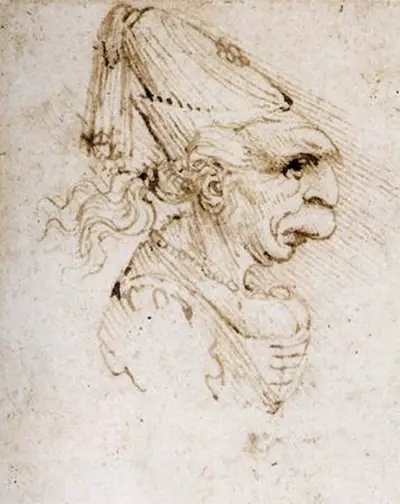Italian caricature works of this era are often referred to as ‘grotesques’. Although Leonardo is more famed for his paintings in the present day, these caricature sketches were the most influential pieces of his art during the 16th, 17th and 18th centuries, and copied by many other artists. ‘Caricature II’ presents a right profile that appears to be an elderly man with a hooked nose, multiple chins and prominent upper lip (or possibly a moustache). However, the long hair, tall medieval hat, necklace and apparent bosom suggest this sketch may be depicting a woman with manly facial features. Whoever this person was, they ignited Leonardo’s desire to capture their interesting profile. The sketch showcases Leonardo’s characteristic sketching style of sweeping but accurate strokes, cross-hatched shading and white space. The shading is particularly prominent around the eye area, providing a somewhat pensive and contemplative expression. Note how multiple parallel lines appear behind the facial profile, providing additional contrast.
Leonardo’s fascination for anatomy and the human form is well documented. He was captivated by unusual and bizarre physiognomy; deformations, malformed profiles and bulbous noses – the more bizarre the better. One 16th century biographer mentioned that Leonardo would follow a person with an interesting face around until he had seen it enough times to memorize it and be able to replicate it on a sketch pad at a later time. One can imagine him pacing the crowded streets of Renaissance Italy, eyes alert for his next fascination. Leonardo drafted a vast number of these sketches and called them ‘visi monstrusi’ (monstrous heads); he also described them as ‘fantastic’ on one of the few written notes that remain on this type of drawing. It is not thought that the intention was for these faces to be the subject of humour and ridicule as per subsequent artists’ work in a similar vein.
This drawing was likely created with a bird feather quill pen and ink; the fluidity of this medium allowed fine detailing and subtlety. The paper used at that time would probably have been created from mashed linen fibres – a very durable material. Combined with careful storage, these materials have contributed to preservation of these sketches for over 500 years. Leonardo’s former pupil and friend Francesco Melzi inherited a collection of drawings and he continued to keep them safely stored. A number of Leonardo’s caricatures eventually ended up in the British Royal Collection via renowned art collector Thomas Howard, 21st Earl of Arundel, where they remain to the present day.


